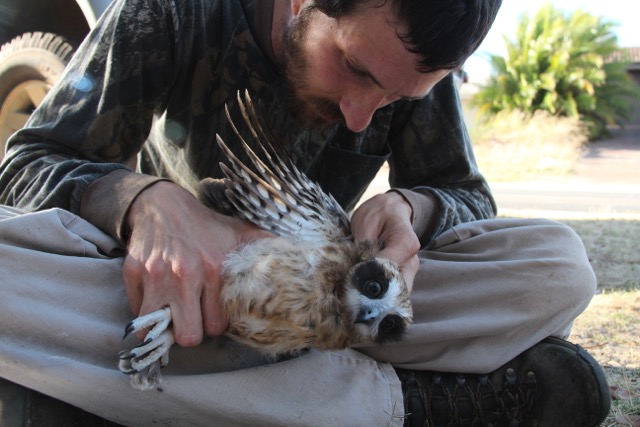(Full article from RATS Tales September 2017)
Secondary rodenticide poisoning of hawks and owls is not just an American problem. The deaths of raptors that have ingested second-generation anticoagulant rodenticides (SGARs) like brodifacoum have also been documented in Europe.
Evidence is now emerging that birds of prey are falling victim to rodenticides in Australia.
Anecdotal reports have linked anticoagulant use to population declines of little eagles around Canberra, and of multiple raptor species in the cane fields of Queensland. Now U.S.-born biologist Michael Lohr, a PhD student at Edith Cowan University in the state of Western Australia, has found traces of SGARs in the bodies of southern boobook owls, a species that appears to be in trouble nationwide. Lohr suspects the boobooks may just be the tip of the iceberg, with other predatory birds and some mammals at risk as well.
Michael Lohr describes his research on booboks in this video – click here to view.
First described by British naturalist Archibald Menzies in the eighteenth century from Western Australian specimens, the southern boobook occurs continent-wide except for the driest deserts. It preys on mouse-size mammals (including bats), small birds, lizards, frogs, and insects and other arthropods. An adaptable bird, the boobook makes itself at home in farmland, orchards, parks, and city streets as well as forest and scrub. This tolerance of human habitation may be its downfall.

According to a recent BirdLife Australia report, boobook numbers are declining in five of the six ecological regions where the owl is found. Lohr says multiple factors—loss of nest sites, inbreeding, disease—may be responsible, with rodenticide poisoning a leading suspect. Forty-six of the 55 dead boobooks he has analyzed were collected near Perth, Western Australia’s capital and largest city. Nearly 90 percent of those 46 birds had been exposed to one of five SGARs, with brodifacoum the most commonly detected. In Western Australia, brodifacoum, bromadiolone, and difenacoum can be purchased at retail outlets; two others, difethialone and flocoumafen, are sold to pest control professionals. Difethialone was found in five samples, flocoumafen in one; warfarin, a first-generation anticoagulant, in two.
Lohr has launched a fundraising campaign to cover the cost of analyzing additional samples. He also wants to look for possible sublethal effects of the poisons, such as compromising the owls’ resistance to parasites.
Rats and mice are the usual pest control targets in Australia’s urban areas. Pindone, a first-generation anticoagulant, is widely used to control exotic rabbits in the countryside. It has been shown to be toxic to wedge-tailed eagles and is blamed for the little eagle’s decline. Lohr has not found pindone in his boobook samples, which seems consistent with the owl’s smaller-than- rabbit-size prey. Some other type of pesticide appears to have been responsible for the recent deaths of five white-bellied sea eagles in the state of Victoria; the eagles, state-listed as vulnerable, may have scavenged illegally poisoned corella parrots.
Brodifacoum use against native rodent crop pests by Queensland cane growers correlated with population crashes of spotted harriers—a hawk similar to the northern harrier—and of five owl species. It was subsequently replaced by less toxic rodenticides. In New Zealand, poisoning of morepork owls by brodifacoum used in mouse-eradication campaigns has been documented. There’s little information on secondary rodenticide poisoning of native Australian mammals, but several species of quoll—small weasel-like marsupials that prey on rodents—may be vulnerable.
Then there’s a potential wild card: the reptile factor. Lohr is concerned that Australia’s many species of rodent-eating snakes and lizards may be rodenticide vectors. “There is next to no research on impacts of SGARs on reptiles, but some of it suggests that at least some species are highly resistant to them and that SGARs may persist in their tissues for a very long time period,” he says. An important part of the prey base for raptors and predatory mammals, reptiles may play a role in moving rodenticides through Australian food webs. He hopes to pursue this angle in future research.
Despite a growing body of evidence of secondary effects, Australian environmental organizations have been slow to pick up on the rodenticide issue. Lohr is part of a working group at his university that intends to review the country’s pesticide laws and regulations, drawing on international expertise to compare them with practices in other countries. In addition, the Australian Pesticide and Veterinary Medicine Authority, the responsible federal agency, will be examining the laws covering SGAR products.
If this new attention leads to more effective controls on rodenticide use, there may be hope that the call of the boobook will remain one of the iconic sounds of the Australian night.
